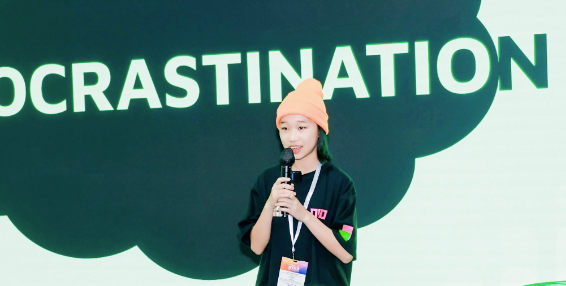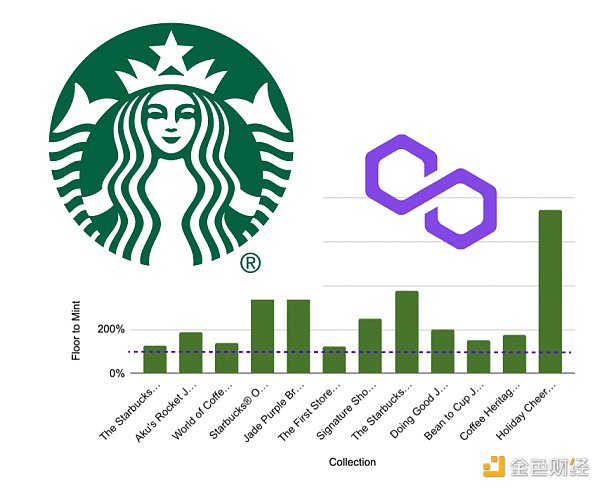In-depth Analysis How did the blockchain data tool Dune rise rapidly?
Analysis How did Dune, a blockchain data tool, rise rapidly?Author: Pete Boyle; Translation: Chain Market
When I started market analysis, I focused on studying Growth Models of Web 2.0 brands. Honestly, I never lacked strategies for analysis. In the Web3 field, things are much more difficult because many projects seem to be following the “community-first” path. This may be good, but many projects are not doing well and they are missing out on some truly accessible opportunities. Dune Analytics is one of the brands that has impressed me in the past few years. I have had conversations with people who have ten years of experience in this field as well as newcomers, and they have all mentioned Dune.
The magic of Dune is that they have not adopted common methods in Web3, such as:
-
Airdrops
-
“Pay-to-follow” community growth
-
Earning models using their own tokens (they don’t have tokens)
They have relied on many strategies that I consider to be traditional public relations and brand awareness strategies, which easily dominate search engine result pages, and all of this stems from the way they build their product. It is an incredible tool and one of the first tools that comes to mind when people talk about blockchain analytics.
So how did Dune rise so quickly?
What is Dune Analytics?
Dune is a web-based application that allows anyone (with some SQL knowledge) to query blockchain data and create visualizations like the one below.
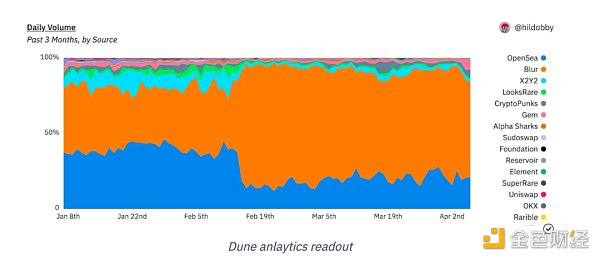
Some people even take the time to build complete dashboards to give others an overview of a project, a series, or even a subset of the industry, like this example about CEXs.
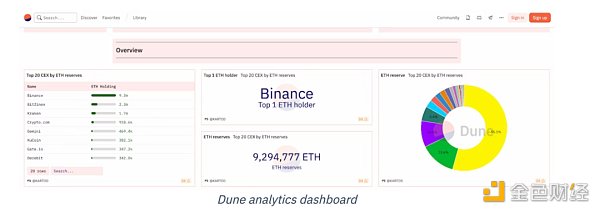
This is a puzzling thing. Dune did not spend money to hire people to build these dashboards, but there are countless new visual contents appearing every day, and they are promoted by the people who make these dashboards (I will explain later why they do this). In my opinion, they are more attention-worthy than many other brands that provide data visualization, such as Nansen.
The question is, how did they do it? Let’s take a look together.
Explosive Growth of Dune
Dune was founded in 2018. But if you observe the existing analytics tools in the market, you will find that this platform didn’t really take off until around 2021. SEMRush’s organic traffic took off in early 2022 (SEMRush’s data is lower and is only considered organic traffic).
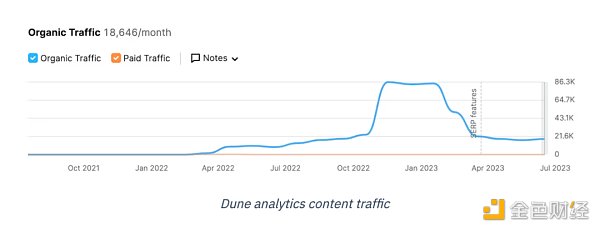
At the same time, they started generating backlinks.
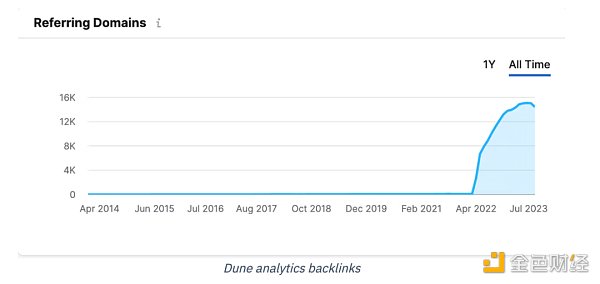
This seems to coincide with the Series A funding round conducted by the brand in August 2021.
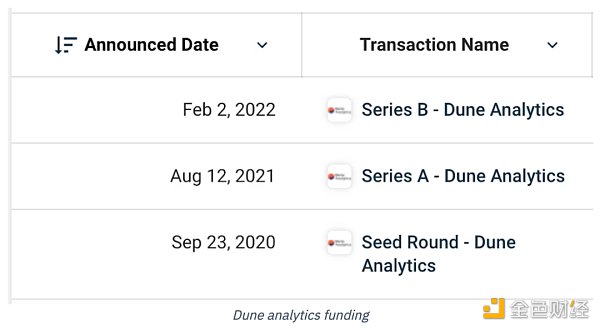
At that time, Dune suddenly appeared in everyone’s field of vision. People talked about it, shared links, and created visual effects like crazy. For a while, Dune was everywhere.
Interestingly, very little of their traffic came from Google search, most of it was direct access. In fact, I was also surprised that more of the traffic was not referral traffic (we will discuss this later).
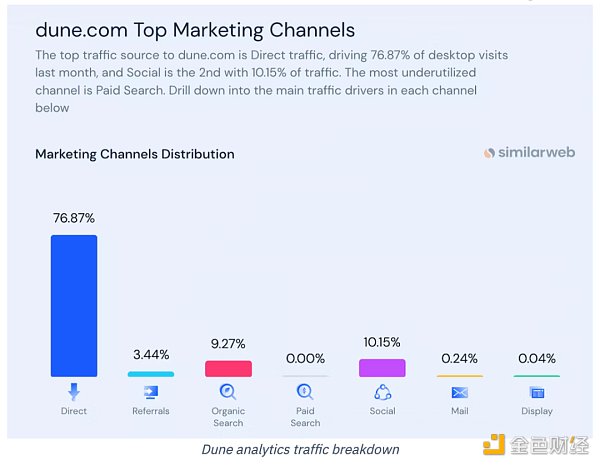
Very few brands can achieve this. They have become synonymous with their category (blockchain analytics), and when someone needs visual analysis, they are usually the preferred service. Therefore, they have gained a large number of users without even needing to search. They just need to go directly to the website. I will analyze how they achieve this and discuss several aspects that I think they can improve.
Dune is helpful for both the supply and demand side of blockchain data visualization
That’s the essence of the problem.
Dune’s platform does an excellent job of helping both the supply and demand sides of data visualization.
Dune helps data scientists get attention and paid work.
Dune also helps people who need analysis (venture capitalists and content creators) get detailed information about the entire industry.
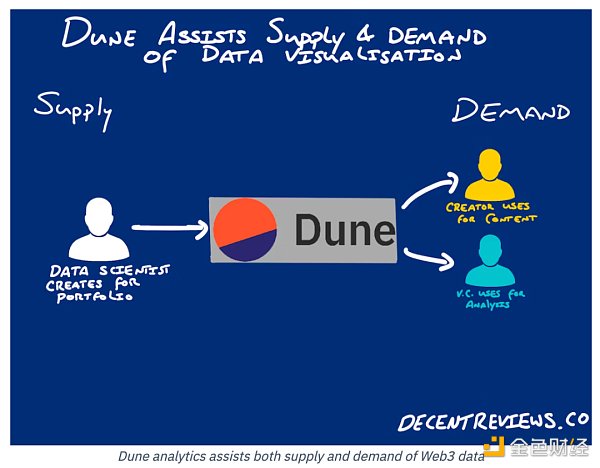
They position themselves in the middle of these two groups, creating a product that is helpful for both. As a result, everyone wants to talk about them. Let’s take a closer look at the details.
Demand – Providing support for content creators, improving PR and visibility
To be frank. The best tools, projects, and products can help users achieve their goals. In most cases, they can make achieving goals faster, easier, or more cost-effective. We are currently in the age of creators. Everyone is creating content, from individuals looking to make some extra income to brands looking to attract thousands of new users, content is the way to achieve this goal.
Content creation can be done through videos, blogs, podcasts, newsletters, or even social media accounts, and the volume of content produced is enormous. And, if I were to be really critical, a lot of the content is quite ordinary, just noise.
The people creating this content are not necessarily experts (at least not yet), they are just motivated enough to invest time in constantly producing content. Building an audience by providing a similar overview to others is a long and difficult process.
However, if you have unique insights, perhaps derived from data analysis, you will immediately stand out. Points supported by data not only carry more weight, but can also attract attention with cool images to help explain various factors.
This is where Dune comes in.
Before Dune came along, analyzing blockchain data was difficult for anyone other than the most professional technicians. But with Dune and some knowledge of SQL, anyone can create simple charts or more detailed analytical dashboards, resulting in various creators referencing Dune in their work.
Brands and influencers use Dune to discuss project growth or interesting changes in the market.
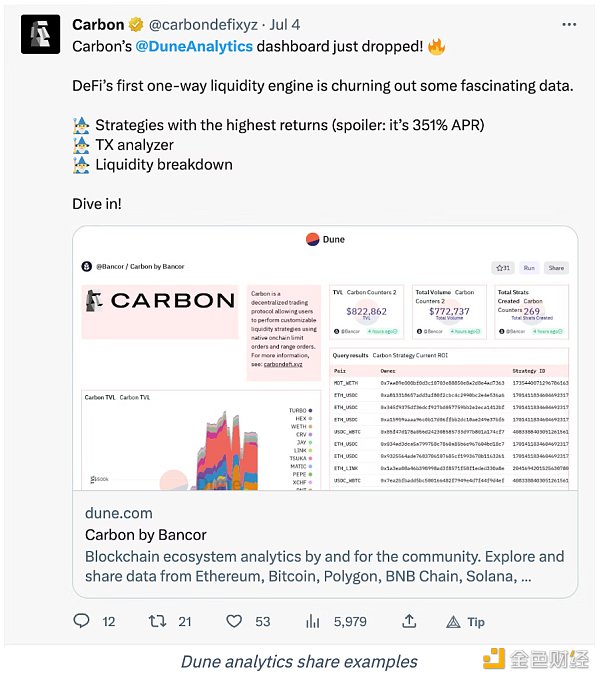
Large publications like Cointelegraph, with millions of readers, use Dune to enhance their reporting.
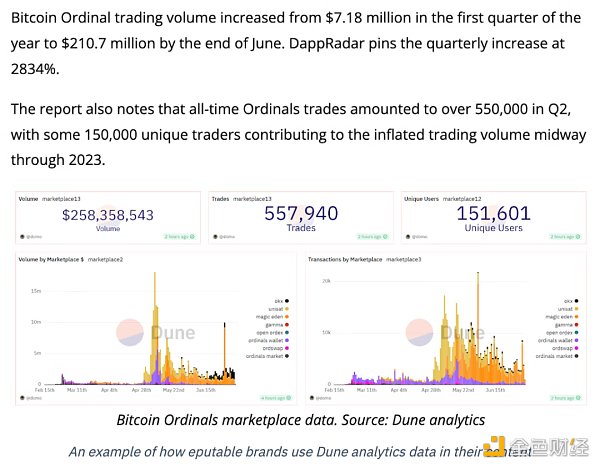
Dune also appears in video tutorials about Web3 analysis.
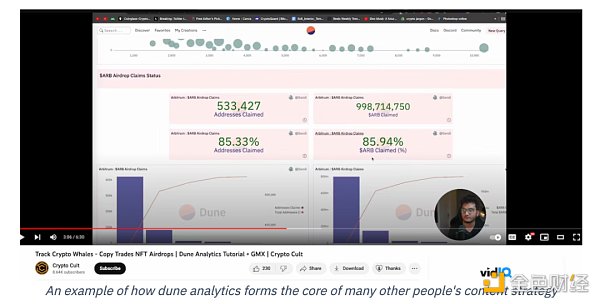
All these references not only expose Dune to a wider market but also bring them backlinks, helping improve their organic ranking on Google.
According to SEMRush data, Dune has about 3.5 million backlinks from over 14,000 domains pointing to its website.

Dune essentially created a product that creators need to grow their business, and if they use this product, they must reference it. The result is significant exposure and backlinks that help brands grow.

Supply – How Dune enables data scientists to create visual effects
When I started researching Dune, the first thing that came to mind was, “How do they get these people to create these visual effects?” I mean, without the visual effects, Dune wouldn’t get the attention and usage from the media.
These people are essentially creating marketing materials for Dune. But why would someone bother learning how to use Dune?
Again, it comes down to Dune relinquishing control and allowing others to benefit from the product. Data scientists are hard to find. You need a specific set of skills and need to prove your abilities to potential employers. Additionally, data science positions are highly competitive and offer relatively high pay. This means that brands looking to hire data scientists only need those who have been validated.
Dune provides an opportunity for newcomers to showcase their skills in this field and find jobs. Anyone can register an account with Dune and start building dashboards for free.
Because public dashboards can be built for free, Dune essentially becomes a portfolio for data scientists.
For example, it’s like:
-
WordPress or Medium for writers (if you like Web3, it’s like Mirror.xyz)
-
YouTube for video editors
-
Figma for user experience designers
Ambitious data scientists can create dashboards that showcase their skills and use them to find work.
This is great because if someone’s visual work is adopted by renowned media outlets like Cointelegraph, creators can get links that attract potential clients.

However, Dune goes a step further and introduces the Wizard program. Those who are very skilled on Dune can become Dune Wizards and showcase their work. They have a special category on the main search page.

As more and more people start to see the work of the Wizards, more brands will reach out to them seeking help in building their own dashboards, as mentioned in this Dune Wizard interview.
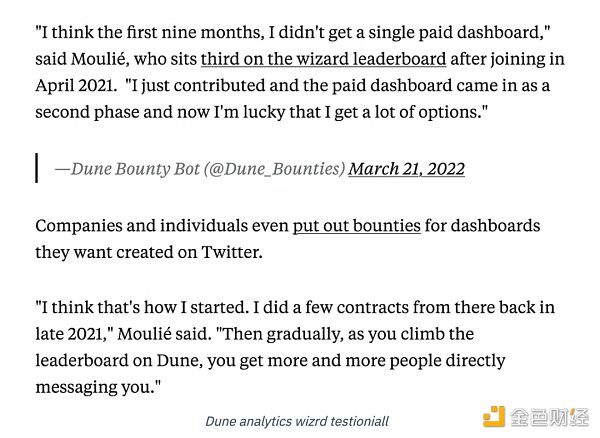
Dune also launched a job recruitment section to help these Wizards apply for and find jobs.
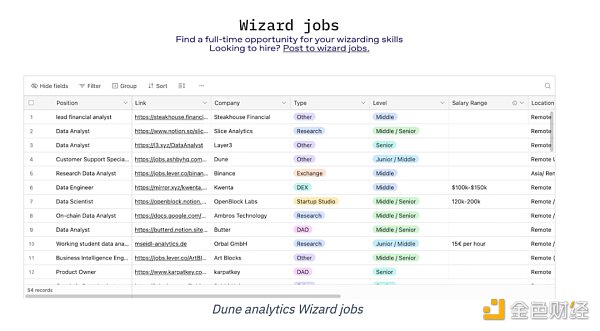
Some of these jobs pay six figures, which is great for beginners who want to understand visualized blockchain data. However, Dune is not their focus; they enable others to pursue their own goals using their product.
Blockchain data supply and demand “freely united”
The whole approach of Dune is to provide tools for others to grow and achieve their goals, and this approach is very effective.
Dune is located at the fascinating intersection of three types of demand:
1. Data scientists – they want to build their portfolios and find jobs;
2. Creators – they need data scientists to create more appealing content;
3. Institutions – they need reputable data scientists to help them understand investment or their own development.
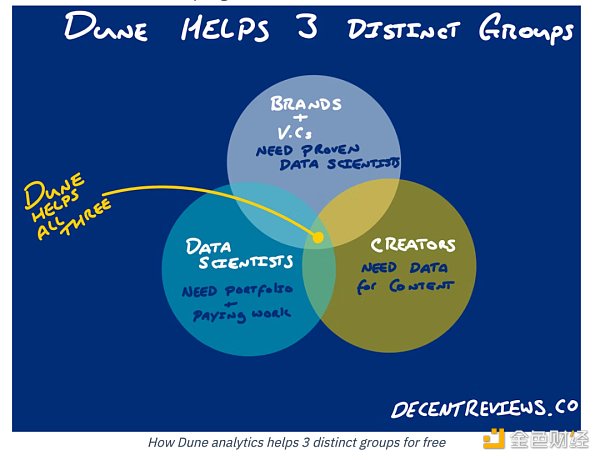
Very few brands can do this. Most brands want the detailed data visualizations they create to be behind a paywall, accessible only to clients. Some brands charge high fees, making it difficult for budding creators to access these tools. And there are brands that are very protective of their intellectual property and do not allow others to share their products.
Dune breaks all these trends. Anyone can create visualizations for free and can use them in any marketing material for free (with proper attribution). At first glance, you might think Dune is just a tool for visualizing massive amounts of blockchain data, but it is much more than that.
Dune is a matchmaking platform that provides opportunities for those who need data and valuable data for data scientists. By helping everyone, they are also helping themselves. But if everything is free, how do they help themselves?
Dune’s revenue model
Although you can create dashboards for free and share visualizations from Dune, they also have a paid plan. They know that everyone wants (or needs) to make their data public to everyone. Many projects require specific on-chain data analysis to help them understand how to develop as a brand, and they need specific analysis for their internal processes. Dune offers a paid plan for this purpose.
Institutions can register for a paid plan to help them with internal data analysis. This is particularly suitable for projects that require a large amount of on-chain data organization or for venture capital firms that need to understand project development.
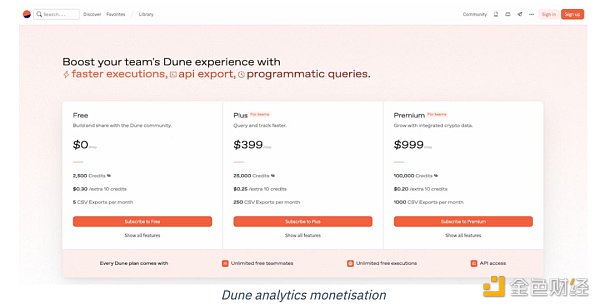
I like this model because you can basically get a complete product demo for free. Anyone considering purchasing a premium plan can access Dune to see what kind of data results they can generate. If they like the data reading, they are more likely to register for a paid plan. If they need help, they can find it directly on the Wizards portal.
Areas that I think Dune is missing out on
I am surprised that Dune has not received more organic traffic. If they notice this, they could greatly increase their traffic. Their domain authority is very high. At the time of writing this article, according to Ahrefs, their DA value is 78. If you don’t know, DA is a third-party metric that assesses the authority of a website. Generally, the higher the DA value (on a scale of 100), the higher the ranking on Google. A DA value of 78 is very high.
However, organic traffic is very low. According to SimilarWeb, organic traffic accounts for less than 10% of the total traffic to the website. Why?
Many visualizations are not optimized for Google search. And I don’t recommend changing them. I think they are already good. So what does Google index for Dune? They tend to index a lot of creator pages.
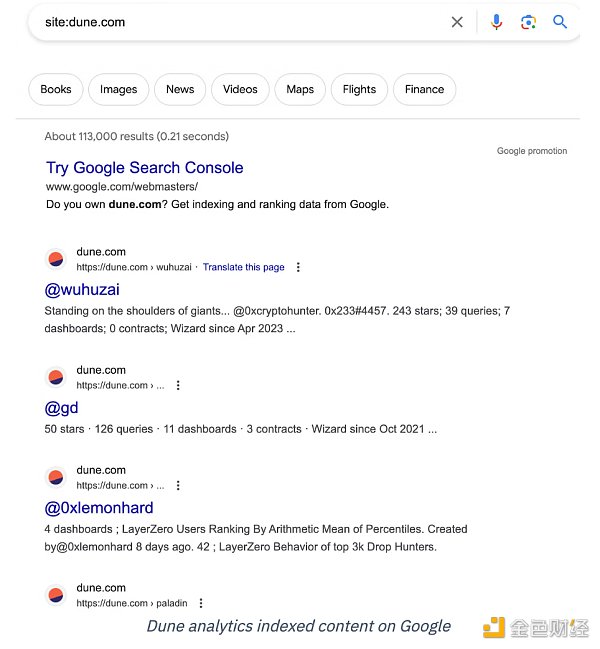
In fact, I can’t imagine how much visibility these pages would have in search. If I were a consultant for Dune and they wanted to increase traffic, I would try to use the platform to create data outputs related to what people are searching for. Here are some basic Crypto search keywords. This is just a small sample.

There are about 20,000 searches per month here, and the competition is relatively low (CMP on a scale of 0-1, with 1 indicating the most competitive). With Dune’s DA, they can create articles that are updated monthly and rank quite high on Google.
They have the following advantages:
-
Recognized authority;
-
Permission to access data directly;
-
An established audience.
They can easily create articles targeting high search volume and use their own data to create unique content. In the above scenario, be careful to avoid providing “financial advice,” but it’s easy to find an angle to avoid this issue. For example, instead of focusing on an article like “Which long-term Crypto to buy today,” they could create an article titled “The most active Crypto in the past X months.” They can still optimize it with the main keywords listed in the image, but avoid making specific investment statements. I imagine they could easily increase their visitor count by hundreds of thousands each month by handling this type of content. Especially considering the relatively weak SEO methods of Web3 at the moment.
Summary of Dune
I believe the success of Dune can be attributed to two key factors:
1. Having an excellent product that caters to multiple communities;
2. Allowing people to use their product for free, thus promoting free public relations.
While this in itself is not a marketing strategy, the way they have built it has made Dune well-known. They have established their business with the goal of helping others. They have not placed themselves at the center of everything but have found themselves there, thanks to their generosity.
This is a true Web3 approach.
I do believe they can do more in terms of traffic, and I hope their monetization model is sufficient to keep them vibrant in their development process.
Original article written by Pete Boyle, translated and compiled by the Chain Market team. All rights reserved to the original author for the English version. For Chinese reprint, please contact the compiler.
We will continue to update Blocking; if you have any questions or suggestions, please contact us!
Was this article helpful?
93 out of 132 found this helpful
Related articles
- Interoperability and Bridging in Blockchain Current Status
- Vice President of the Hong Kong University of Science and Technology, Wang Yang Seizing the opportunity to issue government-backed Hong Kong dollar stablecoin
- Understanding Two RWA Asset Issuance Models in One Article
- Exclusive Interview with Solv Co-founder Meng Yan DeFi and Public Chains Still Have Huge Development Potential, Perfecting Infrastructure is the Key to Mainstream Adoption
- Hive Digital CEO Blockchain and AI can mutually benefit each other
- Why is Ethereum’s position as the king of public blockchains difficult to shake?
- a16z AI combined with blockchain creates four new business models


